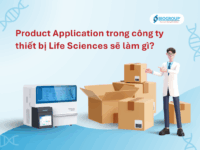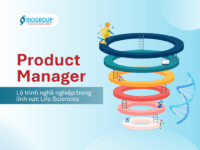Liquid nitrogen tank & storage room – International standard conditions
To ensure quality, samples need to be stored in deep cold conditions in liquid nitrogen (LN₂), and the storage room must maintain temperature and humidity within specified limits. Compliance with international standards (ISO, ISBER, GMP, AABB) not only ensures the integrity of biological samples but also creates a safe and stable working environment. Based on the latest guidelines and practices, Biogroup Vietnam will provide detailed consultations on the necessary conditions for liquid nitrogen tanks & sample storage rooms that meet international standards.

Contents
ToggleLiquid nitrogen tank (Cryogenic storage) – Ultra-cold storage temperature
Storage temperature
Biological samples must be stored at ultra-low temperatures to halt all biological activity completely. It is recommended that the temperature always remain below -135°C. This is the glass transition temperature of water in cells, and below this point, nearly all biological metabolism stops. In practice, stem cell banks typically set the ideal temperature between -150°C and -196°C, approaching the boiling point of liquid nitrogen at -196°C. This temperature ensures that samples are “frozen” permanently without changing or degradation over time.
Vapor phase
When using liquid nitrogen tanks, it is recommended to store samples in the vapor phase of LN₂ rather than immersing them directly in the liquid phase. The reason for this is that if the cryovial containing the sample is immersed in liquid nitrogen, LN₂ gas may seep inside the vial. When the vial is removed to normal environmental conditions, the sudden evaporation of liquid nitrogen can cause it to expand about 700 times, potentially causing the vial to shatter and the sample to scatter, posing a risk of contamination and accidents. Furthermore, immersing samples in the liquid phase poses a risk of cross-contamination, as impurities or microorganisms in the liquid nitrogen could infiltrate multiple vials. Therefore, most cryogenic vial manufacturers recommend storing cryovials in the vapor phase to prevent liquid nitrogen infiltration. The vapor phase of LN₂ (typically around -150°C) still ensures the sample is kept below the safe threshold of -135°C while eliminating the aforementioned risks.
Safety and equipment
To optimize safety, centers should use specialized cryovials with secure caps that can withstand ultra-low temperatures. When liquid-phase storage is required, protective vials or specialized sealed cryogenic tubing should be used to prevent nitrogen infiltration. Operators should wear full protective gear (cold-resistant gloves, safety goggles, face shields, lab coats, etc.) when handling LN₂. Strict adherence to Standard Operating Procedures (SOPs) when handling samples from the liquid nitrogen tank will help ensure the safety of both staff and samples.
Sample storage room conditions – Room temperature & Relative humidity
A standard biological sample storage room needs not only extremely low temperatures in the LN₂ tank but also attention to the ambient room temperature and humidity levels. These factors affect the long-term stability of the samples and the safety of equipment and personnel. Below are key recommendations:
Storage room temperature (Ambient / Controlled Room Temperature – CRT)
If the storage room is frequented by personnel working near the LN₂ tank, the ambient temperature should be maintained at a comfortable and safe level. According to USP <659>, Controlled Room Temperature (CRT) is defined as a range of 20–25°C, allowing fluctuations between 15°C and 30°C. This means the room temperature may occasionally drop to 15°C or rise to 30°C, as long as the average temperature over time does not exceed approximately 25°C (mean kinetic temperature). In ideal conditions, many storage rooms opt for a more tightly controlled range of 20–25°C to ensure stability. Maintaining room temperature within the CRT range helps avoid thermal shock to the samples when transferring them in and out of deep freezers, while also creating a comfortable environment for staff.
Note that the temperature control system should have alarms set when the temperature exceeds the permissible range. Alert limits may be set at 20°C and 25°C, with action limits at 15°C and 30°C. This setup helps detect abnormal temperature fluctuations early, allowing for corrective action before the limits are exceeded.
Relative humidity (RH) of Sample Storage Room
The humidity in the storage room needs to be controlled to avoid long-term damage. Conventionally, an acceptable humidity range is between 30% and 60% RH. However, for sensitive sample storage rooms or those adhering strictly to cGMP guidelines, humidity is often maintained between 30% and 40% RH to ensure a dry, stable, long-term environment. USP <659> also defines a “dry place” for pharmaceutical storage, meaning a place with average humidity not exceeding 40% at 20°C. RH values may briefly fluctuate up to ~45% in short periods, but the average should remain ≤ 40%. For sample storage rooms, the target RH should be around 35%±5%.
Low RH benefits
Low humidity helps minimize mold and bacterial growth over time. A wet environment above 60% RH promotes mold growth, threatening stored samples and causing corrosion to metal equipment. In practice, most microorganisms struggle to grow when the humidity is below ~60%. Specifically, for dry storage rooms, design guidelines recommend maintaining RH at 30–40%, with a maximum of 45% as stated. Therefore, strict humidity control at lower levels ensures a dry, ventilated environment, protecting both samples and equipment during long-term storage.
Biogroup’s recommended sample storage room conditions
Based on international standards and industry recommendations, here is a summary of the environmental conditions Biogroup Vietnam suggests applying to biological and stem cell storage rooms:
- Room temperature: Maintain around 20°C – 25°C (according to CRT standard), with a short-term fluctuation of 15°C – 30°C.
- Relative humidity: Maintain RH between 30% – 60%; ideally control at 30% – 40% RH for long-term stability and a “dry” environment.
- Environmental monitoring: Equipped with continuous temperature and humidity sensors. Set alarms when temperature exceeds ±5°C from the set point or when RH exceeds 45% RH.
- HVAC & Air circulation system: Use an HVAC system (heating, ventilation, and air conditioning) capable of controlling humidity and maintaining a stable temperature. Ensure air filtration and good air circulation in the room to avoid stagnant air. The ventilation system should be powerful enough to prevent nitrogen buildup and maintain a safe oxygen level for staff.
- Maintenance and cleaning: The storage room must be kept clean, avoiding water condensation on walls or ceilings. Regular HVAC system maintenance, filter checks, and cleaning should be performed to ensure efficient equipment operation. Keep daily records of temperature and humidity as part of the Quality Management System (QMS).
(The above conditions are intended to ensure that the sample storage room always meets the strictest environmental storage requirements according to international standards.)
Why is the strict control of room temperature and humidity necessary?
Investing in strict environmental control in sample storage rooms offers numerous practical benefits for both sample quality and operations:
- Protect sample quality: Stable room temperature helps prevent thermal shock to biological samples when transferring from liquid nitrogen tanks to the outside environment. If the room is too hot or too cold compared to the CRT range, the sample may suddenly change, affecting its biological integrity. Low humidity (below 40%) ensures the room remains dry, preventing mold or bacterial growth that could contaminate the sample over time. A stable environment also prevents water condensation on vials or sample tubes, which could lead to contamination or equipment corrosion. In other words, proper temperature and humidity control “supports” the longevity and reliability of stored samples.
- Safety for equipment and personnel: Rooms with proper temperature and humidity standards ensure cryo-equipment (LN₂ tanks, sensors, related machinery) operates efficiently and more durably. For example, high humidity can cause rust and corrosion of metal parts in storage tanks or shelves, and reduce the lifespan of electronic components in alarm systems. Conversely, humidity in the 30-40% range helps prevent these damages. Additionally, a comfortable environment (20–25°C, not too humid) creates a safe and pleasant working condition for staff. This is especially important as staff need to focus on handling precious samples accurately; an ideal working environment minimizes the risk of accidents due to slips (from condensation) or health issues caused by mold.
- Compliance & reputation enhancement: International standards such as ISO 20387 (biobanking), ISBER Best Practices, GMP, or AABB require biological storage facilities to have appropriate environmental control systems. Maintaining a storage room within the CRT temperature and humidity ranges demonstrates strict adherence to professional regulations, boosting the credibility of the organization. This is especially crucial when working with international organizations or undergoing audits, as a CRT/USP-compliant room will more easily meet inspection requirements. In other words, good control of temperature and humidity not only benefits sample quality but also affirms the brand and reliability of the storage facility.
Tools and practices for implementing environmental control
To achieve the ideal conditions mentioned above, sample storage centers need to implement both technology and operational processes:
- Modern HVAC system: Invest in an HVAC system capable of controlling both temperature and humidity in the room. This system should include air conditioning or heating units to maintain room temperature between 20-25°C, along with a dehumidifier or desiccant dryer to keep RH between 30-40%. The HVAC design should ensure adequate air exchange, preventing dead zones for airflow. Additionally, HEPA filters in the ventilation system should be installed to remove dust and microorganisms, keeping the air clean.
- Continuous monitoring with sensors and alarms: Deploy independent temperature and humidity sensors at multiple locations within the room for precise monitoring. These sensors should be connected to a central system or software. When temperature or RH exceeds the set thresholds, the system will activate alarms (sound, light, or even text/email notifications) for timely staff intervention. Typically, alarm levels are set when room temperature deviates by ±5°C from the set point or when relative humidity exceeds 45% (since 45% is the upper short-term limit). Early alerts help prevent environmental issues before they impact samples.
- Calibration and regular testing: All measuring equipment (thermometers, hygrometers) and HVAC systems need to be calibrated and maintained regularly. The calibration schedule may be every 6 months or annually, depending on requirements. This ensures sensors provide accurate results, preventing deviations from standard conditions without detection. Also, periodically check air circulation, door seals, and nitrogen supply valves to detect abnormalities (such as cold leaks or moisture intrusion). All testing and maintenance activities should be logged in an operational journal for quality management and auditing purposes.
- Moisture-resistant room materials: In terms of infrastructure, the storage room should use materials that are moisture-resistant and well-insulated. For example, walls should be painted with moisture-resistant epoxy paint, and floors and ceilings should be made of waterproof, easy-to-clean materials. Avoid using materials that absorb moisture or have porous surfaces in the room (as these can accumulate humidity and microorganisms). Ensure there are no condensation spots on surfaces when the liquid nitrogen tank is operational, which is achieved through good insulation and low RH control. Additionally, the room should have floor drainage or other measures to prevent LN₂ or condensation water leaks.
- Standard operating procedures: Finally, develop and train staff to adhere to standard operating procedures (SOPs) when entering and exiting the sample storage room. For example, limit the duration of room door openings (to prevent excessive heat/moisture exchange with the outside), close LN₂ tank caps carefully after taking samples (to reduce nitrogen evaporation and local humidity), clean instruments before placing them in the room, etc. Perform regular room cleaning, avoid open water sources or chemicals in the room (to prevent moisture buildup). If incidents like liquid nitrogen spills occur, follow safety guidelines. A well-maintained environment relies not only on equipment but also on the discipline of the operators.
Conclusion on liquid nitrogen tank & sample storage room international standards
In summary, to safely store biological samples and stem cells in the long term, centers must ensure that both freezing storage conditions and the room environment meet standards:
- Liquid nitrogen tank: Always store samples in the vapor phase of LN₂, with temperatures below -135°C (optimally between -150°C and -196°C) to halt all biological activity. This prevents sample denaturation and eliminates cross-contamination risks due to nitrogen infiltration.
- Sample storage room: Maintain room temperatures at 20–25°C (fluctuating up to 15–30°C) and humidity at 30–40% RH. Use an integrated HVAC system to control humidity, along with environmental sensors and alarms for continuous monitoring. Ensure the room remains dry, mold-free, and condensation-free, safeguarding both equipment and samples.
- Compliance: These conditions fully align with guidelines from reputable organizations like ISO, ISBER, GMP, and AABB. Strict adherence to these standards not only protects valuable samples but also affirms the storage facility’s professional credibility.
Biogroup Vietnam proudly supports cell therapy centers and stem cell/tissue banks in establishing international-standard storage environments. With in-depth consultation and detailed guidance, proper management of liquid nitrogen tanks and sample storage rooms will help optimize the preservation of invaluable biological assets for the future. Always prioritize the quality of the storage environment—it’s the foundation for sustainable success in the biotechnology industry.
Contact information:
- Website: https://biogroupvietnam.com/public/lien-he
- Hotline: +84 963 621 421
- Email: info@biogroupvietnam.vn
Reference
ISO/ISBER Best Practices, USP <659>, AABB Guidelines, GMP standards, and technical documents on cryogenic biological sample storage. (Details of references are mentioned in the article.)
Categories
- Blog (55)
- Training & Webinar (28)
- Virtual Booth (1)
- New Products & Technologies (45)
- News (41)
- Recruitment (11)




